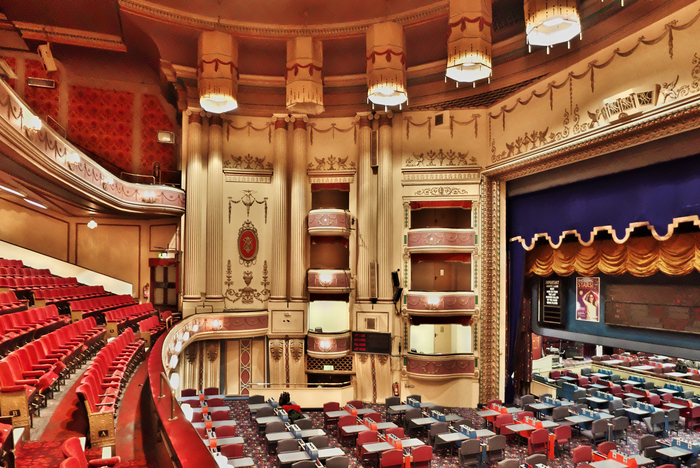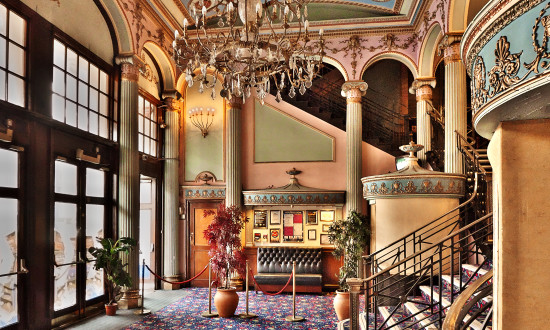Streatham Hill Theatre
One of south London’s most lavish ‘sleeping beauties’ and the last theatre designed by W. G. R. Sprague, the architect responsible for some of the most stunning theatres in London.

- Address
- 110 Streatham Hill, London, SW2 4RD
- Risk Rating
- 7 (Community Value: 3, Star Rating: 2, Risk Factor: 2)
- Local Authority
- London Borough of Lambeth
- Local Group
- The Friends of Streatham Hill Theatre
- Owner
- Ruach City Church (Poll Mount Ltd to May 2022, Hold Land South East Ltd to July 2022)
- Architect
- William George Robert Sprague & W. H. Barton
- Date of Construction
- 1929
- Listing
- Grade II / Asset of Community Value
- Capacity
- c. 2,800
- Database Link
- View in Theatres Database
Significance
Built in 1929, this was the last theatre designed by theatre architect William George Robert Sprague. It is possibly his largest and one of the best-equipped in London outside of the West End. The theatre has an imposing faience facade. The foyer is spacious, with tall gilded Ionic columns and arches, a terrazzo floor, and two round kiosks on each side of the grand central stairway. This sweeps up to dress circle and balcony levels, parting at the centre into two flights with iron balustrading. The auditorium is lavish and has excellent sightlines with two balconies. The foyers, auditorium, and public areas were described as being ‘in the Adam manner’ but are quite eclectic, with friezes of sphinxes, angels, and garlands in abundance. The theatre was hit by a V1 flying bomb in 1944 but was reconstructed in 1950 closely to the original Sprague designs. Original wooden stage machinery is also still in situ, together with the counterweight flying and three-part forestage orchestra lifts.
It was listed Grade II in 1994 as ‘an unusually lavish example of a theatre built in the short-lived revival of building in 1929-30; as a suburban example of this date the building may be unique’. It was first registered as an Asset of Community Value (ACV) in 2018 and was awarded a second ACV term in 2023.
A Statement of Historical Significance, commissioned as a part of the viability study has shown that the theatre is significant on several levels: its place in the work of the original architect, being a rare example of interwar suburban theatre buildings, its aesthetic completeness, quality and scale - and its role in the collective cultural memory of its local community.
Why is this theatre at risk?
Streatham Hill Theatre has been on the Theatres at Risk Register since 2018. It was added to Historic England’s Heritage at Risk Register in 2021.
Streatham Hill Theatre was added to our register when, in 2017, the bingo operator, who held a sub-lease on the building, closed its operation in the main auditorium leaving the future of the building uncertain.
The closure of bingo also brought the end of local amateur community theatre use in the building.
A theatre company that Theatres Trust, and local campaign group The Friends of Streatham Hill Theatre, were supporting had been in discussion with the building’s owner regarding purchasing the property. However, in May 2022 it was reported that the theatre had been sold to another buyer, property development company, Hold Land South East Ltd for £2.76m.
Despite the efforts of the campaign group and theatre company to discuss options on the building, in July of the same year, Hold Land South East Ltd sold the theatre to church group, Ruach City Church for a reported £4m. The theatre company remains interested in the building including a potential shared use of the venue.
Rauch City Church sold its base in neighbouring Brixton Hill on the same day in 2022 that it bought the Streatham Hill Theatre, with an arrangement to remain in those Brixton Hill premises until the 31 June 2024. The organisation also owns the Grade II* listed Gaumont State, Kilburn.
In June 2024, the church moved out of its former premises and started using Streatham Hill Theatre for Sunday services. However, it has yet to apply for planning permission for a change of use for public worship or religious instruction. While this could provide a sympathetic alternative use of an historic theatre, there are concerns regarding continued and meaningful community access to the venue. There are also concerns regarding the overall scale of repair that will need to be undertaken and in ensuring that any works do not inadvertently damage historic theatre fittings, equipment and stage machinery.
The church has undertaken some internal works to the building to allow it to use the premises. These works have not required listed building consent. Unfortunately, they appear to have done little to repair the deterioration within the main theatre foyer which still has signs of flaking plaster and general deterioration, The theatre also suffers flooding in the basement – it is not known whether the recent building works have rectified this issue.

Theatre potential
There is currently a shortage of both workspace and arts / cultural facilities in the area, which this building could address.
In 2020, campaign group The Friends of Streatham Hill Theatre raised funds to complete a viability study and economic impact assessment to investigate the theatre’s potential for a sustainable future. Funding came from the Mayor of London’s 2020 Crowdfund London, Lambeth Council and Theatres Trust Theatres at Risk Capacity Building Programme. The report, published in April 2021, confirmed that restoration and phased reuse of the theatre as a leisure and entertainment venue is a viable proposal, and would generate footfall, jobs, and economic growth, adding over £70m to the local economy over 30 years.
Lambeth Council’s ‘Streatham Investment and Growth Strategy June 2019 – 2030’, also includes a priority action to explore opportunities for the Streatham Hill Theatre as part of its objective of providing spaces for better and new experiences in the area. Furthermore, it states that the theatre building provides a transformative opportunity to offer a major leisure and entertainment venue with the potential for workspace for creative, digital and cultural industries.
Current situation
Local campaign group The Friends of Streatham Hill Theatre remains very proactive and has achieved successes both in fundraising and in harnessing strong community and creative industry support for the building. Theatres Trust has been supporting the group since its formation providing fundraising and viability study advice.
In December 2023, the group successfully applied for a new Asset of Community Value listing for the building (the original listing from 2018 having expired). The council’s original and continued decision to list the theatre as an ACV remains important as it recognises the theatre’s cultural and social role in its community and is a sign of the council’s support for the building.
Theatres Trust continues to seek discussion with the church to understand how it may use the building, its plans for necessary repair and restoration, and whether the building will be opened for use by the community. We also hope to discuss the possibility of shared use of the space so that Streatham Hill Theatre may once again be open for live performance use for the benefit of the local community.
We will continue to support The Friends of Streatham Hill Theatre and work with them, the council, and other key stakeholders, to ensure that the building, its historic fabric, and community and live performance use are protected.
Update May 2025
We objected to the application for change of use to a 'Place of Worship' and suggested a mixed use compromise solution. We also did not support listed building consent associated with the change of use of Streatham Hill Theatre, as there was no detail or appraisal of works the applicant intends to carry out.
Photos, Streatham Hill Theatre, Tim Hatcher